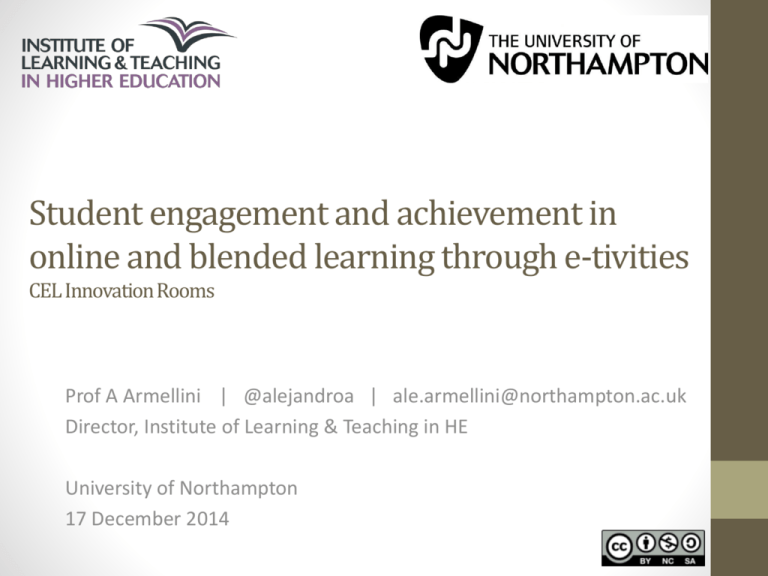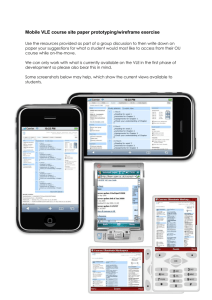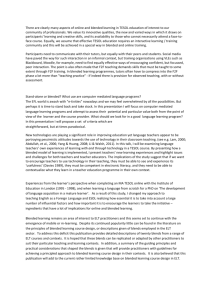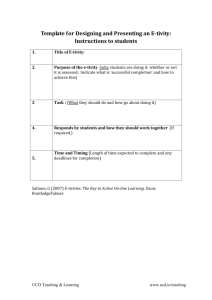Presentation Alejandro Armellini - Centre for Education and Learning
advertisement

Student engagement and achievement in online and blended learning through e-tivities CEL Innovation Rooms Prof A Armellini | @alejandroa | ale.armellini@northampton.ac.uk Director, Institute of Learning & Teaching in HE University of Northampton 17 December 2014 1. Principles 2. Enhancing quality 3. Hands-on, part 1: an online course on study skills 4. Pedagogical modelling 5. Developing a storyboard 6. Conclusions @alejandroa Plan 2 One learning outcome? … plan something different to pilot next week in your teaching @alejandroa By the end of this session, you’ll be able to… 3 • Transformational learning experiences through inspirational teaching • Low cost, high value for our students and colleagues • Knowledge and learning and open, mobile, connected and scalable • Overlapping modes of study: ‘blended’ = ‘campus & mobile’ • Robust QE process @alejandroa Principles 4 Responsive-reactive Good practice based on identified needs & evidence Developmentalincremental Innovative ideas backed up by evidence of need From niche to mainstream enhancement Innovative approaches aligned with organisational culture and needs @alejandroa Quality enhancement Radicalinnovative 6 Now… the SSAS hands-on bit Study Skills for Academic Success Purpose - To offer you an opportunity to engage with, discuss and provide feedback as a SSAS participant. - To explore opportunities for reusing variants of SSAS in your institution. Task a. Go to http://bit.ly/ssas-join. Please use password Berlin b. You will need to sign up for a Coursesites account if you do not already have it c. Have a good look around the course. Chat to your neighbours. d. Go to item 1: Welcome – Start here! and do e-tivities 1.1 and 1.2 in full. Reflection and Feedback Be prepared to comment of your experience on this course using this shared document (http://tinyurl.com/SSAS-OEB14). Time 30-40 minutes. 7 F2F session: analysis, discussion, reflection & goal setting Post-session online work: consolidation & evaluation @alejandroa Pre-session cognitive exposure – multimedia resources 10 ? F2F session: analysis, discussion, reflection & goal setting Post-session online work: consolidation & evaluation @alejandroa Pre-session cognitive exposure – multimedia resources 11 Pre-session activation of schemata – asynchronous online tasks F2F session: analysis, discussion, reflection & goal setting Post-session online work: consolidation & evaluation @alejandroa Pre-session cognitive exposure – multimedia resources 12 Pre-session cognitive exposure – multimedia resources Pre-session activation of schemata – asynchronous online tasks F2F session: analysis, discussion, reflection & goal setting Post-session online work: consolidation & evaluation @alejandroa Key ingredient! 13 VLE design benchmarks Focus Key features @alejandroa Level 14 VLE design benchmarks Level Focus Key features Foundation Delivery @alejandroa Absolute minimum expected Course information, handbook and guides Learning materials 15 VLE design benchmarks Level Focus Key features Foundation Delivery Intermediate Participation In addition to ‘Delivery’: Online participation designed into the course. Tasks provide meaningful formative scaffold. Online participation encouraged and moderated, but not assessed. @alejandroa Essential in all ‘blended’ courses Absolute minimum expected Course information, handbook and guides Learning materials 16 VLE design benchmarks Level Focus Key features Foundation Delivery Intermediate Participation In addition to ‘Delivery’: Online participation designed into the course. Tasks provide meaningful formative scaffold. Online participation encouraged and moderated, but not assessed. Collaboration In addition to ‘Delivery’: Regular learner input designed into course & essential throughout. Online tasks provide meaningful scaffold to formative and summative assessment. Collaborative knowledge construction central to a productive learning environment & part of assessment. Advanced Essential in all fully online courses @alejandroa Essential in all ‘blended’ courses Absolute minimum expected Course information, handbook and guides Learning materials 17 VLE design benchmarks Level Focus Foundation Delivery Objective Intermediate Participation ENGAGEMENT Collaboration ACTIVE LEARNING Essential in all ‘blended’ courses @alejandroa COMPLIANCE (or REPOSITORY!) Advanced Essential in all fully online courses 18 CAIeRO = Carpe Diem @ Northampton Design for effective online and blended learning: A two-day intensive workshop @alejandroa Creating Aligned Interactive educational Resource Opportunities 19 CAIeRO review prototype check reality @alejandroa Plan + action storyboard blueprint 20 @alejandroa Who: size & participants 21 @alejandroa Why: to design a great course, fast 22 Learning Outcomes Start End Student-generated content resulting from the e-tivities Assessment 24 @alejandroa 25 @alejandroa @alejandroa Action plan 26 27 @alejandroa Storyboard a short 6-week course: Principles of transnational education Safer cycling in 21st Century cities Learning innovation for today’s higher education students Building diverse and effective teams Organising successful academic events 2 weeks online 2 weeks f2f 2 weeks online Target audience: staff at your institution. 4 hours of student work per week. 1. Decide on (a) level (e.g. undergraduate, PG, CPD) and (b) two key learning outcomes 2. Storyboard it! @alejandroa • • • • • 28 Weeks 2 1.1 E-tivity 3 4 5 6 2.1 E-tivity 3.1 E-tivity 4.1E-tivity @alejandroa 1 6.1 E-tivity 3.2 E-tivity 1.2 E-tivity 5.1 E-tivity 2.2 E-tivity Assess & feedback Assess & Assess & Assess & Assess & feedback feedback feedback feedback 29 @alejandroa The resource is not the course 30 @alejandroa Content dump vs learning pathway Trawl through stuff vs scaffold Learning outcomes hidden in a pile vs explicit alignment Mess vs structure Push content vs engage Upload vs design Resource vs course Deliver vs teach 31 32 @alejandroa “Adapting to characteristics of students and responding to their development is an inherent aspect of pedagogy. […] These adaptations can be considered innovations if are based [sic] on a new idea and when they have the potential to improve student learning, or when they are linked with other outcomes […]” @alejandroa Pedagogic innovation (Vieluf, Kaplan, Klieeme & Bayer, 2012) 35 “What is an innovation in one education system may be well-established practice in another; what is appreciated as an improvement may be rejected elsewhere.” @alejandroa Pedagogic innovation (Vieluf et al., 2012) 36 Old wine New bottles Learners generate content as homework, which is used creatively in the following seminar Flipped classroom Course in a (digital) box xMOOC Talk to your classmates Social learning Learners bring their books and pencil cases (among many other technologies) Bring your own device (BYOD) Loops of personalised assessment for learning & feedback Dynamic assessment Study on the bus or train, on campus or at home Mobile learning Teaching methods Pedagogies @alejandroa Old wine in new bottles? 37 Innovating pedagogy. Really? Very often, there’s hardly any innovation @alejandroa Old wine is often good, as is the quality of some of the new bottles Things don’t have to be innovative to be good What is the problem to which [innovation x] is the solution? 38 • Adapting to the challenging climate not good enough: take action, take risks, evaluate, refine • Pilot small but also pilot big • Build capacity, model, review, scale up • Think assessment for innovation • Engage others in the change, share ownership • Disseminate, invite feedback • Remember: students want ‘contact time’ @alejandroa Summary: shaping the futures we want 39 An opportunity for enhancement @alejandroa Requirements from professional and accreditation bodies (including Royal Colleges) can be accommodated, and normally improved, within a blended, learner-centred mode of study 40 Viable and preferred futures for learning An opinion A hunch • There is far less pedagogic innovation than meets the eye @alejandroa • We can imagine, but not forecast future scenarios for learning A wish • Teaching, in any mode of study, will be conducted with expertise, commitment and passion, and with a focus on benefiting our students and their communities 41 • Gilly Salmon’s blog: http://www.gillysalmon.com/blog.html • Armellini, A. & Nie, M. (2013). Open educational practices for curriculum enhancement. Open Learning 28(1) 7-20. • Rogerson-Revell, P., Nie, M. & Armellini, A. (2012) An evaluation of the use of voice boards, e-book readers and virtual worlds in a postgraduate distance learning Applied Linguistics and TESOL programme. Open Learning, 27(2), 103-119. • Nie, M., Armellini, A., Witthaus, G. & Barklamb, K. (2011). How do e-book readers enhance learning opportunities for distance work-based learners? ALT-J, Research in Learning Technology, 19(1), 19-38. • Nie, M., Armellini, A., Randall, R., Harrington, S. & Barklamb, K. (2010). The role of podcasting in effective curriculum renewal. ALT-J, Research in Learning Technology 18(2), 105-118. • Armellini, A., & Aiyegbayo, O. (2010). Learning design and assessment with e-tivities. British Journal of Educational Technology 41(6), 922-935. • Armellini, A., & Jones, S. (2008). Carpe Diem: Seizing each day to foster change in e-learning design. Reflecting Education, 4(1), 17-29. Available from http://tinyurl.com/58q2lj • Salmon, G., Jones, S., & Armellini, A. (2008). Building institutional capability in e-learning design. ALTJ, Research in Learning Technology, 16(2), 95-109. • Salmon, G. (2013). E-tivities: The key to active online learning (2nd ed.). London and New York: Routledge. • Salmon, G. (2011). E-moderating: The key to teaching and learning online (3rd ed.). New York: Routledge. Ale.Armellini@northampton.ac.uk @alejandroa @alejandroa Reading 42 Image by Topgold on Flickr Thank you To access: search ARMELLINI on Slideshare.net Professor Alejandro Armellini 17 December 2014 Ale.Armellini@northampton.ac.uk | @alejandroa






